Hailing from the rainforests of Colombia, Philodendron brandtianum features silvery green leaves that bring a sparkle to every room. And you’ve got a choice with this one, since it can be grown both as a climbing or hanging plant.
With heart-shaped leaves adorned with unique silver variegation and juvenile leaves with a penchant for pink, there’s never a dull moment with Philodendron brandi. But don’t be fooled by its exotic origins, because it can feel right at home in your living room with just a little TLC.
In this Philodendron brandtianum care guide, we’ll go over everything from lighting and watering to temperature and propagation. We’ll also tackle common issues you may encounter and share tips to ensure your plant thrives.
Table of Contents
Philodendron Brandtianum Plant Care Guide
History, Habitat, and Characteristics
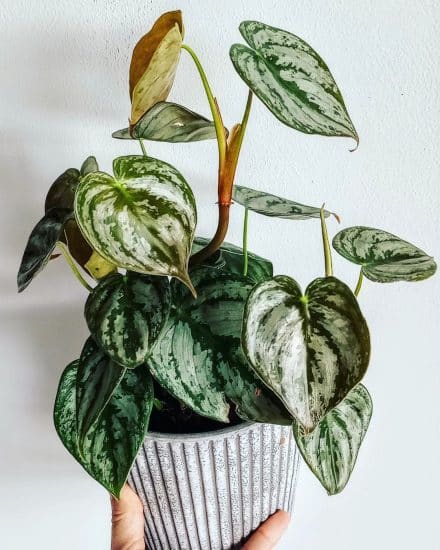
Philodendron brandtianum, also known as silver leaf philodendron, has been casually making its way from the lush southern Colombian and northern Brazilian rainforests right into our homes. It’s also native to seasonally dry areas of Bolivia.
With its olive green, heart-shaped leaves splashed with silver or white patches, Philodendron brandtianum is reminiscent of its popular kin, Philodendron heteraceum and Philodendron brasil.
While they’re all from the Araceae family, there is a twist. Each Philodendron brandtianum leaf sports unique silver variegation, truly making this climbing philodendron one of a kind. You’ll never grow tired of looking at it!
Fun fact: The silver leaf philodendron is a triple threat — it can grow either as a terrestrial plant on land, an epiphyte that grows on other plants toward the light, or a hemiepiphyte that starts out on the ground as a seed and then grows up on other plants.
Oh, and did we mention the party trick? When Philodendron brandi sprouts new leaves, they come out with a punchy pink hue. These babies eventually mature into the classic olive-green and silver combo we know and love.
Since it hails from the humid tropics of Colombia, the Philodendron brandtianum plant loves a moist environment and plenty of indirect light. And as a climbing plant, it’ll be more than happy with a support structure like a moss pole to cling onto.
Light
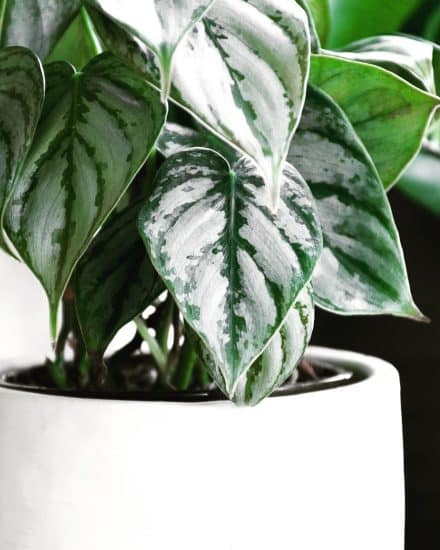
Your Philodendron brandtianum plant thrives in medium to bright indirect sunlight. Sure, some direct sunlight is good, but avoid scorching afternoon sun and full sun exposure like the plague (read: right up against unfiltered south or west-facing windows).
Philodendron brandtianum light requirements aren’t complicated, but you’ll notice dull leaves and slow growth if it’s not getting enough light. What to do? Move it to a spot with more indirect bright light or give full spectrum LED grow lights a shot!
But what if your Philodendron brandtianum is basking in too much direct sunlight? Its leaves could scorch, looking burned and damaged. In that case, try relocating your plant to a spot with more filtered light, like near an east-facing window or behind sheer curtains.
Ideally, you want your silver leaf philodendron to enjoy a mix of bright indirect light and gentle morning sun.
Want to help your Philodendron brandtianum grow evenly and get its share of light from all angles? Rotate it every few weeks. This only keeps your plant looking gorgeous from front to back, but also promotes healthy growth.
Water

Philodendron brandtianum can be a bit picky when it comes to water, so it’s important to get the balance just right. Too much water will make the leaves turn yellow and rot, while not enough can cause those crispy edges we all want to avoid.
So, what’s the trick? It’s simple, really. Just let the top few inches of soil dry out before giving it another drink. To make sure you’re getting it right, you can feel the soil with a finger.
And don’t forget, drainage is super important — make sure you’re using a pot with drainage holes or take the plant out of its decorative pot when you water it.
How can you tell if your silver leaf philodendron is getting too little water? Look out for curling leaves, crispy edges, and a bit of yellowing. If you see any of these signs, your plant buddy is telling you it’s thirsty! Make sure to increase your watering frequency a bit to keep it happy.
On the other hand, if your silver leaf philodendron is getting too much water, you might notice yellow leaves, soggy soil, and a rotting smell (blech). In this case, let that soil dry out before the next watering session, and be sure to cut back on the frequency.
Temperature and Humidity

When it comes to caring for your Philodendron brandtianum, understanding the ideal temperature and humidity levels is essential. Here’s a breakdown of what you need to know to help your plant thrive indoors.
The silver leaf philodendron is a tropical plant, so it prefers a temperature range between 60 to 82°F (16 to 28°C). In these conditions, your plant will be cozy and comfortable.
Remember that silver leaf philodendron is sensitive to temperature fluctuations, so be cautious of drafty windows and doors, and avoid placing it near air conditioning units or radiators. If you notice any wilting or drooping leaves, it might be a sign that the temperature is either too high or too low.
Philodendron brandtianum loves a good amount of humidity to thrive. It’s best to maintain a humidity level of 60% or more for your plant. Higher humidity levels, combined with the right temperature, can even encourage faster growth.
Watch out for signs that indicate whether the humidity level is too low (brown leaf tips or edges) or too high (yellowing leaves) for your Philodendron brandtianum plant.
To raise humidity levels, consider using a humidifier or place your silver leaf philodendron in a room with higher humidity, such as a bathroom.
If that’s not feasible, you can also try the pebble tray method: place a tray filled with water and pebbles beneath indoor plants to increase the local humidity. However, avoid misting the leaves directly; if they get wet, wipe them off gently with a cloth to avoid any potential pest issues.
Soil and Planting
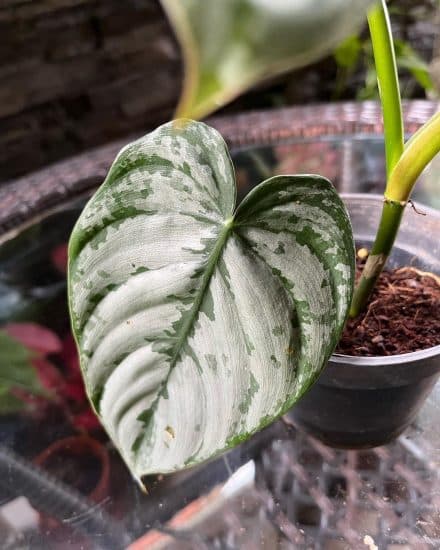
Tropical plants like the Philodendron brandtianum appreciate a well-draining potting mix. Buy an aroid mix from a store or make your own chunky potting mix that breathes with high quality all purpose soil, worm castings, perlite, and coco coir. A potting combination like this allows its roots to grip and grow properly, promoting a strong and healthy root system.
Avoid using heavy or compacted silver leaf philodendron soil, as this can prevent proper air circulation and drainage. A soil mix that doesn’t drain well could lead to wilting, yellow leaves, slowed growth, or root rot. Make sure to use the recommended Philodendron brandtianum soil mentioned above.
Fertilizer
Fertilize your Philodendron brandtianum lightly but regularly during the spring and summer, when it’s growing more actively. Use a balanced fertilizer like liquid Gold Leaf, but be cautious not to over-fertilize.
Signs of over-fertilizing include leaf burn, browning leaf tips, and weak or leggy growth. If you suspect your Philodendron brandtianum has received too much fertilizer, flush the soil with water to remove excess nutrients and reduce the frequency of fertilizing.
Always follow the recommended dosage instructions on the fertilizer label, and consider diluting the solution to prevent over-fertilization in the future.
Repotting
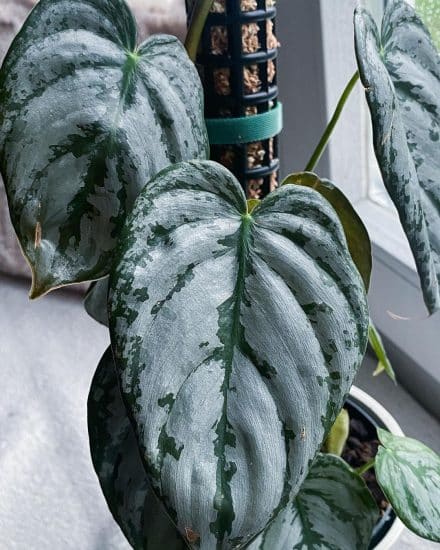
You’ll need to repot your Philodendron brandtianum every two or three years (or sooner if you spot roots poking out of the bottom of the pot or notice stunted growth). When repotting, choose a container one or two inches larger than the current pot, and make sure it has at least one drainage hole.
Spring is the best time for Philodendron brandtianum repotting, since this is when the plant is actively growing and can more easily adapt to its new environment. When planting or repotting, give your silver leaf philodendron a moss pole to climb. Climbing philodendron put out larger leaves and have faster growth.
Propagation
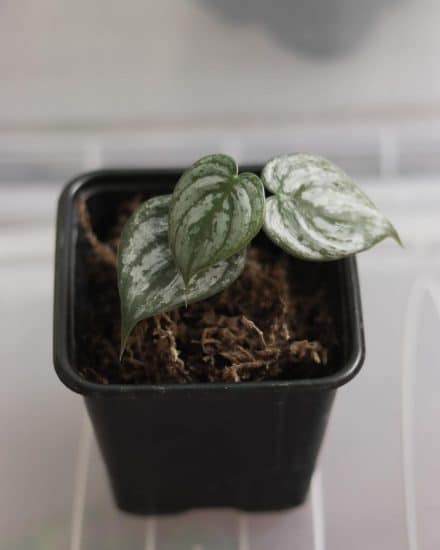
Decided it’s time to propagate Philodendron brandtianum to share the love? Stem cuttings in soil or water are the most easiest and most popular methods by far. Grab your gardening gloves, and let’s dive in!
Propagate Philodendron brandtianum by stem cutting:
- Find that perfect stem! Choose a healthy stem with at least one leaf, and if possible, one with visible aerial roots (the longer, the better for soil; smaller roots are better suited for the water method).
- Give it a snip! Grab those sterilized gardening shears and cut a single node from the stem to propagate silver leaf philodendron.
- Remove extra leaves near the bottom of the stem to prevent any soggy leaf situations in your water (or smothered under soil).
- Submerge those aerial roots in filtered or bottled water inside a small container. If you’re planting in soil . . . do just that! Keep the soil moist but not drenched. If you’re going the soil route, you’re done here.
- Change the water every few days and let your cutting bask in a warm, humid area with plenty of light. In a few weeks, you’ll see root growth! Once they’re a few inches long, you can transplant the cutting into our recommended Philodendron brandtianum soil (see the “Soil and Planting” section above).
Common Issues

Remember, silver leaf philodendrons are like us — they need a bit of love and care to thrive. So, let’s dive into two common concerns: brown leaf tips and yellow leaves.
Brown Leaf Tips

Don’t worry — it’s likely that your plant is just craving a bit more humidity. Those unique olive green leaves may need extra moisture to maintain their beauty, especially in drier or more humid climates.
You see, things like heaters and air conditioners can really dry out your home, and your plant feels it, too. To help it out, try increasing the humidity around your silver leaf philodendron (a humidifier or even a tray of water and pebbles nearby can work wonders).
If that doesn’t cut it, sunlight might be the culprit. Direct sunlight can really damage those delicate leaves, so be sure to find a spot with bright, indirect sunlight instead. Keep an eye on your plant over the next few weeks, and you should see those tips perk up in no time!
Yellowing Leaves

When you see yellowing leaves on your Philodendron brandtianum, it’s your plant’s way of saying, “Help! I need a watering adjustment.” Both overwatering and underwatering can lead to this problem.
The fix is typically a well-draining potting mix, preferably containing peat moss or coco coir, and a balanced watering schedule.
Give the top few inches of potting soil a chance to dry out between waterings, and be sure the pot has drainage holes (nobody likes soggy feet, right?). If you suspect overwatering, you might need to repot in fresh, dry soil and cut back on the watering frequency. Keep an eye on your plant’s progress, and it should bounce back in no time!
Pests and Diseases
Even though Philodendron brandtianum diseases and pests aren’t as common as with some other houseplants, they can still run into a few problems, including spider mites and root rot. If this happens, you’re not the first to deal with it, and there are tried and true solutions.
Spider Mites

Although our Philodendron brandtianum friend isn’t super pest-prone, spider mites can be real troublemakers when plants get dry (they hate water). These little critters are super tiny and love to hang out on the undersides of leaves, sipping away at the plant’s sap.
When they’re around, you might notice that the foliage looks speckled, discolored, or even has some fine webbing between the leaves and stems.
Solution: First things first, let’s isolate that silver leaf philodendron — we don’t want those pesky mites spreading to your other green buddies! Get rid of any super-infested leaves and then gently wipe the remaining critters off using a damp cloth or sponge.
To really show them who’s boss, use some insecticidal soap or neem oil (follow the directions on the label). Just make sure you get both the tops and bottoms of the leaves!
To keep those mites from crashing your plant party again, make sure your Philodendron brandtianum has enough humidity (spider mites really hate moisture). Try placing a tray of water nearby or using a humidifier.
Good air circulation is also a big help, so think about getting a small fan for your plant collection. And, of course, keep an eye on those leaves to catch any future infestations early on.
Root Rot
Root rot can sneak up on even the best indoor plant caretakers – including those looking after Philodendron brandtianum. Too much water or poor drainage can turn roots into a soggy mess, and that’s never good.
If your Philodendron brandtianum is suffering from rotting roots, you’ll probably notice some leaves getting yellow, wilting, and just a general decline in how happy and healthy it looks.
Solution: Time to take action! Carefully take your Philodendron brandtianum out of its pot and check out the roots. Using some sterilized scissors (gotta keep things clean), cut away any black, slimy, or mushy roots. Once you’ve done a little pruning, repot your plant pal in some fresh, well-draining soil. Oh, and don’t forget to use a clean pot with drainage holes.
Preventing rotting roots starts with nailing that watering routine. The most critical thing here is to change your watering habits; don’t let history repeat itself! Water your Philodendron brandtianum only when the top inch or two of soil feels dry. Adding some perlite or vermiculite to the soil can help with drainage, too.
Conclusion

You’ve made it to the end of our guide on growing Philodendron brandtianum indoors! You should feel confident in your ability to care for philodendron brandtianum plants, even when unexpected issues arise.
(If not, ask us for help!)
Philodendron brandtianum care summary:
- Ensure medium to bright indirect light for optimal growth.
- Water only when the top few inches of soil are dry.
- Keep temperature levels between 60-82°F (16-28°C) and humidity above 60%.
- Use a well-draining, chunky potting mix to promote healthy root development.
- Regularly repot and fertilize during the active growing season, being mindful not to over-fertilize.
If you enjoyed our guide, please share it with fellow plant lovers. Reach out if you have any additional questions about caring for your Philodendron brandtianum. We’re always here to troubleshoot and love hearing about all of your plant success stories!
Take care, and happy gardening!
FAQ
What is the difference between Philodendron brandtianum and wild form?
The Philodendron brandtianum, or Philodendron brandi, is a cultivated variety of the wild form of the plant, which is native to the tropical rainforests of Colombia. While both the cultivated and the wild forms share many characteristics, such as captivating heart-shaped leaves and silver variegation, Philodendron brandtianum has been bred for its unique and attractive appearance.
This cultivated variety is typically more ornamental and visually appealing, making it a popular choice for indoor gardeners. The wild form, on the other hand, may display more genetic variation and be better adapted to its natural environment.
Are Philodendron brandtianum rare?
While Philodendron brandi is not extremely rare, it is considered to be less common compared to some other Philodendron varieties. Its unique silver variegation, heart-shaped leaves, and climbing nature make it a fairly sought-after plant. However, due to increased interest in exotic houseplants, it is becoming more widely available in nurseries and online plant shops.
Does Philodendron brandtianum trail?
Yes, Philodendron brandi can trail, but it’s primarily a climbing plant. In its natural habitat in the Colombian rainforest, it would climb trees and other structures to reach light. As a houseplant, Philodendron brandi prefers having a support structure, like a moss pole or trellis, to climb and attach itself to. This promotes healthy growth and allows the plant to develop larger leaves.
However, if left without support, the plant may trail and cascade down the sides of the pot. In this case, however, it may not grow as vigorously.
Is Philodendron brandtianum fast growing?
Philodendron brandtianum has a moderate growth rate compared to other Philodendron species. Its growth speed is influenced by various factors, like lighting, temperature, humidity, and overall care.
Providing your Philodendron brandtianum with the ideal conditions, including medium to bright indirect light, temperatures between 60-82°F (16-28°C), and a humidity level of 60% or more, will encourage faster and healthier growth. Fertilization during the active growing season (spring and summer) and a regular watering schedule can help your plant grow quickly and stay healthy.
Is Philodendron brandtianum toxic?
This plant is considered toxic due to the calcium oxalate crystals it produces, so be sure to keep it away from curious children and pests.


